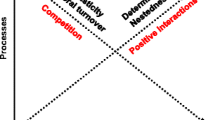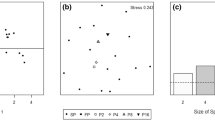Abstract
Biotic interactions are suggested to be key factors structuring bacterioplankton community assembly but are rarely included in metacommunity studies. Eutrophication of ponds and lakes provides a useful opportunity to evaluate how bacterioplankton assembly is affected by specific environmental conditions, especially also by biotic interactions with other trophic levels such as phytoplankton and zooplankton. Here, we evaluated the importance of deterministic and stochastic processes on bacterioplankton community assembly in 35 shallow ponds along a eutrophication gradient in Belgium and assessed the direct and indirect effects of phytoplankton and zooplankton community variation on bacterioplankton assembly through a path analysis and network analysis. Environmental filtering by abiotic factors (suspended matter concentration and pH) explained the largest part of the bacterioplankton community variation. Phytoplankton community structure affected bacterioplankton structure through its effect on variation in chlorophyll-a and suspended matter concentration. Bacterioplankton communities were also spatially structured through pH. Overall, our results indicate that environmental variation is a key component driving bacterioplankton assembly along a eutrophication gradient and that indirect biotic interactions can also be important in explaining bacterioplankton community composition. Furthermore, eutrophication led to divergence in community structure and more eutrophic ponds had a higher diversity of bacteria.



Similar content being viewed by others
Data Availability
Sequences are available in the European Nucleotide Archive under the project number PRJEB47016.
Code Availability
Not applicable.
References
Caruso T, Chan Y, Lacap DC et al (2011) Stochastic and deterministic processes interact in the assembly of desert microbial communities on a global scale. ISME J 5:1406–1413. https://doi.org/10.1038/ismej.2011.21
Chen W, Pan Y, Yu L et al (2017) Patterns and processes in marine microeukaryotic community biogeography from Xiamen coastal waters and intertidal sediments, southeast China. Front Microbiol 8:1912. https://doi.org/10.3389/fmicb.2017.01912
Walker SC, Cyr H (2007) Testing the standard neutral model of biodiversity in lake communities. Oikos 116:143–155. https://doi.org/10.1111/j.2006.0030-1299.15300.x
Jeraldo P, Sipos M, Chia N et al (2012) Quantification of the relative roles of niche and neutral processes in structuring gastrointestinal microbiomes. Proc Natl Acad Sci U S A 109:9692–9698. https://doi.org/10.1073/pnas.1206721109
Zhou J, Ning D (2017) Stochastic community assembly: does it matter in microbial ecology? Microbiol Mol Biol Rev 81(4):e00002-17. https://doi.org/10.1128/mmbr.00002-17
Langenheder S, Lindström ES (2019) Factors influencing aquatic and terrestrial bacterial community assembly. Environ Microbiol Rep 11:306–315. https://doi.org/10.1111/1758-2229.12731
Van Der Gucht K, Cottenie K, Muylaert K et al (2007) The power of species sorting: local factors drive bacterial community composition over a wide range of spatial scales. Proc Natl Acad Sci U S A 104:20404–20409. https://doi.org/10.1073/pnas.0707200104
Zwirglmaier K, Keiz K, Engel M et al (2015) Seasonal and spatial patterns of microbial diversity along a trophic gradient in the interconnected lakes of the Osterseen Lake District, Bavaria. Front Microbiol 6:1168. https://doi.org/10.3389/fmicb.2015.01168
Lauber CL, Ramirez KS, Aanderud Z et al (2013) Temporal variability in soil microbial communities across land-use types. ISME J 7:1641–1650. https://doi.org/10.1038/ismej.2013.50
Wang SY, Sudduth EB, Wallenstein MD et al (2011) Watershed urbanization alters the composition and function of stream bacterial communities. PLoS ONE 6:e22972. https://doi.org/10.1371/journal.pone.0022972
Verreydt D, De Meester L, Decaestecker E et al (2012) Dispersal-mediated trophic interactions can generate apparent patterns of dispersal limitation in aquatic metacommunities. Ecol Lett 15:218–226. https://doi.org/10.1111/j.1461-0248.2011.01728.x
Souffreau C, Van der Gucht K, van Gremberghe I et al (2015) Environmental rather than spatial factors structure bacterioplankton communities in shallow lakes along a >6000km latitudinal gradient in South America. Environ Microbiol 17:2336–2351. https://doi.org/10.1111/1462-2920.12692
Chase JM, Biro EG, Ryberg WA, Smith KG (2009) Predators temper the relative importance of stochastic processes in the assembly of prey metacommunities. Ecol Lett 12:1210–1218. https://doi.org/10.1111/j.1461-0248.2009.01362.x
Brum JR, Hurwitz BL, Schofield O et al (2016) Seasonal time bombs: dominant temperate viruses affect Southern Ocean microbial dynamics. ISME J 10:437–449. https://doi.org/10.1038/ismej.2015.125
Hedlund K, Regina IS, Van Der Putten WH et al (2003) Plant species diversity, plant biomass and responses of the soil community on abandoned land across Europe: Idiosyncracy or above-belowground time lags. Oikos 103:45–58. https://doi.org/10.1034/j.1600-0706.2003.12511.x
Burns AR, Stephens WZ, Stagaman K et al (2016) Contribution of neutral processes to the assembly of gut microbial communities in the zebrafish over host development. ISME J 10:655–664. https://doi.org/10.1038/ismej.2015.142
Hanashiro FTT, Mukherjee S, Souffreau C et al (2019) Freshwater bacterioplankton metacommunity structure along urbanization gradients in Belgium. Front Microbiol 10:743. https://doi.org/10.3389/fmicb.2019.00743
Berga M, Östman Ö, Lindström ES, Langenheder S (2015) Combined effects of zooplankton grazing and dispersal on the diversity and assembly mechanisms of bacterial metacommunities. Environ Microbiol 17:2275–2287. https://doi.org/10.1111/1462-2920.12688
Wu X, Xi W, Ye W, Yang H (2007) Bacterial community composition of a shallow hypertrophic freshwater lake in China, revealed by 16S rRNA gene sequences. FEMS Microbiol Ecol 61:85–96. https://doi.org/10.1111/j.1574-6941.2007.00326.x
Özen A, Šorf M, Trochine C et al (2013) Long-term effects of warming and nutrients on microbes and other plankton in mesocosms. Freshw Biol 58:483–493. https://doi.org/10.1111/j.1365-2427.2012.02824.x
Eiler A, Bertilsson S (2004) Composition of freshwater bacterial communities associated with cyanobacterial blooms in four Swedish lakes. Environ Microbiol 6:1228–1243. https://doi.org/10.1111/j.1462-2920.2004.00657.x
Kiersztyn B, Chróst R, Kaliński T et al (2019) Structural and functional microbial diversity along a eutrophication gradient of interconnected lakes undergoing anthropopressure. Sci Rep 9. https://doi.org/10.1038/s41598-019-47577-8
Monchamp ME, Spaak P, Domaizon I et al (2018) Homogenization of lake cyanobacterial communities over a century of climate change and eutrophication. Nat Ecol Evol 2:317–324. https://doi.org/10.1038/s41559-017-0407-0
Scheffer M, Carpenter S, Foley JA et al (2001) Catastrophic shifts in ecosystems. Nature 413:591–596. https://doi.org/10.1038/35098000
Rigosi A, Carey CC, Ibelings BW, Brookes JD (2014) The interaction between climate warming and eutrophication to promote cyanobacteria is dependent on trophic state and varies among taxa. Limnol Oceanogr 59:99–144. https://doi.org/10.4319/lo.2014.59.01.0099
Ger KA, Hansson LA, Lürling M (2014) Understanding cyanobacteria-zooplankton interactions in a more eutrophic world. Freshw Biol 59:1783–1798. https://doi.org/10.1111/fwb.12393
Huisman J, Codd GA, Paerl HW et al (2018) Cyanobacterial blooms. Nat Rev Microbiol 16:471–483. https://doi.org/10.1038/s41579-018-0040-1
Vonlanthen P, Bittner D, Hudson AG et al (2012) Eutrophication causes speciation reversal in whitefish adaptive radiations. Nature 482:357–362. https://doi.org/10.1038/nature10824
Declerck S, De Bie T, Ercken D et al (2006) Ecological characteristics of small farmland ponds: associations with land use practices at multiple spatial scales. Biol Conserv 131:523–532. https://doi.org/10.1016/j.biocon.2006.02.024
Verbeek L, Vanhamel M, van den Berg E et al (2018) Compositional and functional consequences of environmental change in Belgian farmland ponds. Freshw Biol 63:581–596. https://doi.org/10.1111/fwb.13095
De Bie T, De Meester L, Brendonck L et al (2012) Body size and dispersal mode as key traits determining metacommunity structure of aquatic organisms. Ecol Lett 15:740–747. https://doi.org/10.1111/j.1461-0248.2012.01794.x
Schloss PD, Gevers D, Westcott SL (2011) Reducing the effects of PCR amplification and sequencing artifacts on 16S rRNA-based studies. PLoS ONE 6:e27310. https://doi.org/10.1371/journal.pone.0066723
Lundin D, Severin I, Logue JB et al (2012) Which sequencing depth is sufficient to describe patterns in bacterial α- and β-diversity? Environ Microbiol Rep 4:367–372. https://doi.org/10.1111/j.1758-2229.2012.00345.x
Gómez-Rodríguez C, Baselga A (2018) Variation among European beetle taxa in patterns of distance decay of similarity suggests a major role of dispersal processes. Ecography (Cop) 41:1825–1834. https://doi.org/10.1111/ecog.03693
Dray S, Legendre P, Peres-Neto PR (2006) Spatial modelling: a comprehensive framework for principal coordinate analysis of neighbour matrices (PCNM). Ecol Modell 196:483–493. https://doi.org/10.1016/j.ecolmodel.2006.02.015
Logue JB, Lindström ES (2010) Species sorting affects bacterioplankton community composition as determined by 16S rDNA and 16S rRNA fingerprints. ISME J 4:729–738. https://doi.org/10.1038/ismej.2009.156
Ren L, Jeppesen E, He D et al (2015) pH influences the importance of niche-related and neutral processes in lacustrine bacterioplankton assembly. Appl Environ Microbiol 81:3104–3114. https://doi.org/10.1128/AEM.04042-14
Vilar AG, Van Dam H, Van Loon EE et al (2014) Eutrophication decreases distance decay of similarity in diatom communities. Freshw Biol 59:1522–1531. https://doi.org/10.1111/fwb.12363
Dai W, Zhang J, Tu Q et al (2017) Bacterioplankton assembly and interspecies interaction indicating increasing coastal eutrophication. Chemosphere 177:317–325. https://doi.org/10.1016/j.chemosphere.2017.03.034
Griffiths RI, Thomson BC, James P et al (2011) The bacterial biogeography of British soils. Environ Microbiol 13:1642–1654. https://doi.org/10.1111/j.1462-2920.2011.02480.x
Buchan A, LeCleir GR, Gulvik CA, González JM (2014) Master recyclers: features and functions of bacteria associated with phytoplankton blooms. Nat Rev Microbiol 12:686–698. https://doi.org/10.1038/nrmicro3326
Kasprzak P, Padisák J, Koschel R et al (2008) Chlorophyll a concentration across a trophic gradient of lakes: an estimator of phytoplankton biomass? Limnologica 38:327–338. https://doi.org/10.1016/j.limno.2008.07.002
Kirk KL (1991) Inorganic particles alter competition in Grazing Plankton : the role of selective feeding. Ecology 72:915–923. https://doi.org/10.2307/1940593
Birtel J, Matthews B (2016) Grazers structure the bacterial and algal diversity of aquatic metacommunities. Ecology 97:3472–3484. https://doi.org/10.1002/ecy.1612
Lima-Mendez G, Faust K, Henry N et al (2015) Determinants of community structure in the global plankton interactome. Science 348:1–10. https://doi.org/10.1126/science.1262073
Leibold MA, Mikkelson GM (2002) Coherence, species turnover, and boundary clumping elements of meta-community structure. Oikos 97:237–250. https://doi.org/10.1034/j.1600-0706.2002.970210.x
Gentile AR, Barceló-Cordón S, van Liedekerke M (2009) Soil country analyses - Belgium
Bell T (2010) Experimental tests of the bacterial distance-decay relationship. ISME J 4:1357–1365. https://doi.org/10.1038/ismej.2010.77
Heino J, Tolkkinen M, Pirttilä AM et al (2014) Microbial diversity and community-environment relationships in boreal streams. J Biogeogr 41:2234–2244. https://doi.org/10.1111/jbi.12369
Smith VH (2007) Microbial diversity-productivity relationships in aquatic ecosystems. FEMS Microbiol Ecol 62:181–186. https://doi.org/10.1111/j.1574-6941.2007.00381.x
Waide RB, Willig MR, Steiner CF et al (1999) The relationship between productivity and species richness. Annu Rev Ecol Syst 30:257–300. https://doi.org/10.1146/annurev.ecolsys.30.1.257
Jürgens K, Arndt H, Rothhaupt KO (1994) Zooplankton-mediated changes of bacterial community structure. Microb Ecol 27:27–42. https://doi.org/10.1007/BF00170112
Acknowledgements
We thank Kristien Brans, Carla Denis, Jessie Engelen, Melissa Schepens and for their contributions to the fieldwork and laboratory analyses. We also thank the different TippingPond partners at ISARA, University of Oldenburg, and Uppsala University for their help with the landscape analyses and their contributions to the general development of the TippingPond project.
Funding
This work was financially supported by the ERA-Net BiodivERsA project TippingPond, nationally financed by Belspo, and by KU Leuven Research Fund excellence center financing PF/2010/07. Fabio Toshiro T. Hanashiro is supported by the Science Without Borders program (process number: 245968/2012–1).
Author information
Authors and Affiliations
Contributions
Fabio Toshiro T. Hanashiro, Luc De Meester, and Caroline Souffreau contributed to the study conception and design. Material preparation and data collection were performed by Fabio Toshiro T. Hanashiro, Matthias Vanhamel, Andros T. Gianuca, Laura Verbeek, and Edwin Van den Berg. Data analyses were performed by Fabio Toshiro T. Hanashiro, Shinjini Mukherjee, and Caroline Souffreau. The first draft of the manuscript was written by Fabio Toshiro T. Hanashiro, and all authors commented on previous versions of the manuscript. All authors read and approved the final manuscript.
Corresponding author
Ethics declarations
Ethics Approval
Not applicable.
Consent of Participate
Not applicable.
Consent for Publication
Not applicable.
Conflict of Interest
The authors declare no competing interest.
Supplementary Information
Below is the link to the electronic supplementary material.
Rights and permissions
About this article
Cite this article
Hanashiro, F.T.T., De Meester, L., Vanhamel, M. et al. Bacterioplankton Assembly Along a Eutrophication Gradient Is Mainly Structured by Environmental Filtering, Including Indirect Effects of Phytoplankton Composition. Microb Ecol 85, 400–410 (2023). https://doi.org/10.1007/s00248-022-01994-x
Received:
Accepted:
Published:
Issue Date:
DOI: https://doi.org/10.1007/s00248-022-01994-x




